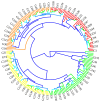Performance, Agro-Morphological, and Quality Traits of Durum Wheat (Triticum turgidum L. ssp. durum Desf.) Germplasm: A Case Study in Jemâa Shaïm, Morocco
- PMID: 40431073
- PMCID: PMC12115076
- DOI: 10.3390/plants14101508
Performance, Agro-Morphological, and Quality Traits of Durum Wheat (Triticum turgidum L. ssp. durum Desf.) Germplasm: A Case Study in Jemâa Shaïm, Morocco
Abstract
The productivity and resilience of durum wheat have been enhanced through the selection of accessions, optimizing agronomic and quality traits to address environmental challenges. This study evaluates the performance of 219 durum wheat accessions, including 120 elite lines from a national breeding program (G1 to G120), 63 international lines (G121 to G183), 27 Moroccan varieties (including Faraj, Karim, Tomouh, Marzak, Amria, Chaoui, IRDEN, and others), and nine landraces (G211 to G219, from Imilchil, Rich, and Taounate regions). Trials were conducted at the Jemâa Shaïm experimental station (INRA-Morocco) with an "Alpha lattice" design and two replications. Significant correlations were observed between spike length (SL) and number of spikelets per spike (SPS) (r = 0.950; p < 0.001), and between grain yield (GY) and thousand-kernel weight (TKW) (r = 0.530; p < 0.01), while no correlation was found between quality parameters and GY (r = 0.010; p > 0.05). Principal component analysis (PCA) revealed that agronomic traits explained 77.12% of variability, while quality traits accounted for 95.54%. Elite lines exhibited a high yellow pigment index (14.90), important for technological quality. Traditional landraces performed well in spike length (8.78 cm), thousand-kernel weight (50.23 g), protein content (17.07%), and gluten content (36.90%). Moroccan varieties such as Faraj achieved a grain yield of 6.12 t/ha, while international lines showed the highest SDS value (9.39 mL). These findings highlight the potential of diverse accessions for developing high-yielding, high-quality durum wheat.
Keywords: agro-morphological traits; durum wheat; elite lines; gluten content and grain yield; inter-group genetic diversity; international lines; landraces; protein content.
Conflict of interest statement
The authors declare no conflicts of interest.
Figures







Similar articles
-
SSR markers and seed quality traits revealed genetic diversity in durum wheat (Triticum durum Desf.).Mol Biol Rep. 2021 Apr;48(4):3185-3193. doi: 10.1007/s11033-021-06385-y. Epub 2021 May 11. Mol Biol Rep. 2021. PMID: 33974178
-
Phenotypic Parent Selection Within a Khorasan Wheat Collection and Genetic Variation in Advanced Breeding Lines Derived by Hybridization With Durum Wheat.Front Plant Sci. 2019 Nov 20;10:1460. doi: 10.3389/fpls.2019.01460. eCollection 2019. Front Plant Sci. 2019. PMID: 31850007 Free PMC article.
-
Genetic diversity of Ethiopian durum wheat (T. turgidum subsp. durum) landraces under water stressed and non stressed conditions.Heliyon. 2023 Jul 17;9(7):e18359. doi: 10.1016/j.heliyon.2023.e18359. eCollection 2023 Jul. Heliyon. 2023. PMID: 37519732 Free PMC article.
-
Genetic approaches to exploit landraces for improvement of Triticum turgidum ssp. durum in the age of climate change.Front Plant Sci. 2023 Jan 27;14:1101271. doi: 10.3389/fpls.2023.1101271. eCollection 2023. Front Plant Sci. 2023. PMID: 36778704 Free PMC article. Review.
-
From ancient to old and modern durum wheat varieties: interaction among cultivar traits, management, and technological quality.J Sci Food Agric. 2019 Mar 30;99(5):2059-2067. doi: 10.1002/jsfa.9388. Epub 2018 Nov 8. J Sci Food Agric. 2019. PMID: 30267406 Review.
Cited by
-
Monte carlo simulation for evaluating spatial dynamics of toxic metals and potential health hazards in sebou basin surface water.Sci Rep. 2025 Aug 12;15(1):29471. doi: 10.1038/s41598-025-15006-8. Sci Rep. 2025. PMID: 40796641 Free PMC article.
References
-
- Smutka L., Steininger M., Miffek O. World Agricultural Production and Consumption. AGRIS-Line Pap. Econ. Inform. 2009;1:3–12.
-
- Smutka L., Steininger M., Maitah M., Škubna O. Agrarian Perspectives XXIV: Proceedings of the 24th International Scientific Conference. Czech University of Life Sciences Prague, Faculty of Economics and Management; Prague, Czech Republic: 2015. The Czech Agrarian Foreign Trade—Ten Years after the EU Accession; pp. 385–392.
-
- Wegren S.K., Elvestad C. Russia’s Food Self-Sufficiency and Food Security: An Assessment. Post-Communist Econ. 2018;30:565–587. doi: 10.1080/14631377.2018.1470854. - DOI
LinkOut - more resources
Full Text Sources

